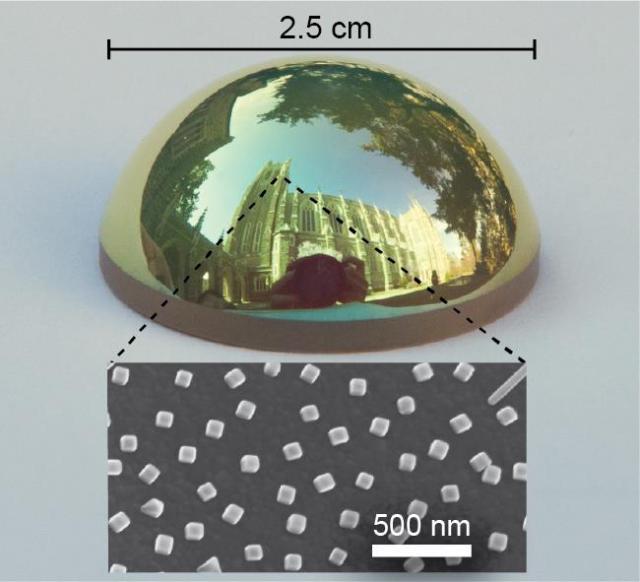Nov 12 2015
A novel technology that uses silver nanocubes to bring true color to infrared cameras has been developed which can 'see' in the visible and infrared radiation. This is an improvement on current technology that only measures the intensity of infrared radiation and not the specific frequencies.
 A curved object covered with the coating that absorbs all red light, which leaves the object with a green tint. A closer look reveals that the surface is covered with tiny 100 nanometer silver cubes.
A curved object covered with the coating that absorbs all red light, which leaves the object with a green tint. A closer look reveals that the surface is covered with tiny 100 nanometer silver cubes.
Conventional infrared imaging systems may seem colorful on screen, since objects that are warm appear whiter and redder compared to their cooler surroundings. However, these images are not made up of real color, but are based on the amount of thermal and/or infrared radiation captured by the camera.
More detailed information about the objects that are imaged, like their chemical composition, can be obtained by identifying the different wavelengths and/or colors of the infrared spectrum.
The team at Duke University, led by Professor Maiken Middelsen, demonstrated that their perfect absorbers could be used to see small bands of electromagnetic spectrum, from the visible to near infrared region.
The new fabrication technology can be easily scaled up and can be applied to any kind of surface geometry. The cost of this technique was much less than the absorption technologies currently available.
By incorporating this technology in advanced thermal imaging systems, higher sensitivity can be achieved and production costs of thermal imaging systems can be reduced significantly. This technology has a wide scope of applications, including masking heat signatures of objects.
By borrowing well-known techniques from chemistry and employing them in new ways, we were able to obtain significantly better resolution than with a million-dollar state-of-the-art electron beam lithography system.
This allowed us to create a coating that can fine-tune the absorption spectra with a level of control that hasn’t been possible previously, with potential applications from light harvesting and photodetectors to military applications.
Maiken Middelsen - Duke University
A branch of physics called plasmonics is the root of the new technology. Using this technology, the surface is first coated with a thin gold film by evaporation. The second step is the laying of a thin polymer layer of just a few nanometers thick. Finally, a coating of silver cubes, each of which is 100 nm in size, is applied.
This doesn’t require top-down fabrication such as expensive lithography techniques and we don’t make this in a clean room a postdoctoral researcher in Mikkelsen’s laboratory. We build it from the bottom up, so the whole thing is inherently cheap and very scalable to large areas.
Gleb Akselrod - Duke University
When light is incident on the surface, particular colors, i.e. photons of specific frequencies, are trapped at the nanocube surface as plasmons, which are packets of energy. This energy is dissipated as heat in the form of thermal radiation.
The thickness of the polymer film and the number and size of the silver nanocubes determine the absorption capacity of the coating. By altering these parameters suitably, different wavelengths of light can be absorbed, starting from the visible spectrum to near infrared.
What is so attractive about the film/nanocube system is its remarkable simplicity and flexibility. The unique absorbing properties of the nanocubes can be predicted with straightforward formulas, making it easy to quickly determine recipes for surface coatings that provide desired spectral properties.
The nanocube system eliminates, or at least vastly reduces, cost and manufacturing issues, so that we can focus on impacting exciting application areas such as photovoltaics or thermal coatings.
Prof. David R. Smith - Duke University
By controlling the colors of light absorbed by a material, the emitted wavelengths of thermal radiation can be controlled. Altering nanocubes such that they absorb wavelengths relating to thermal radiation, the natural thermal radiation of the object (also known as black body radiation) can be masked or suppressed.
Innovative and low cost cameras, which can see different infrared colors, can be made by coating photodetectors so that only specific wavelengths of infrared light are absorbed.
We haven’t made the device that’s actually going to take that energy and convert it to an electrical signal yet. That’s going to be the next step.
Gleb Akselrod - Duke University
The research has been reported in the online edition of Advanced Materials on the 9th of November.